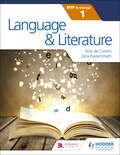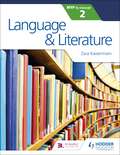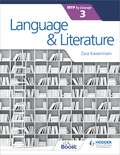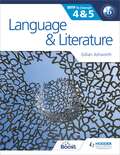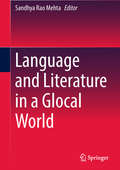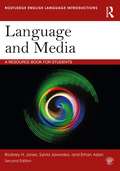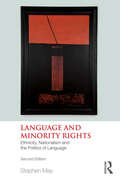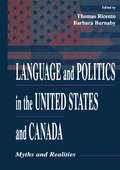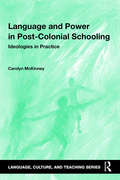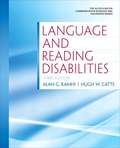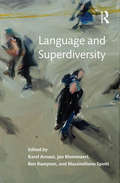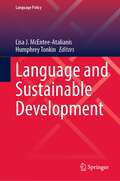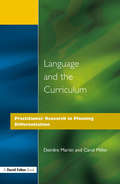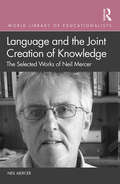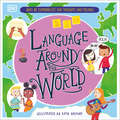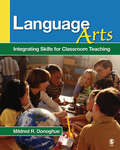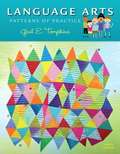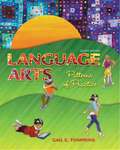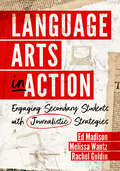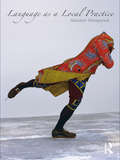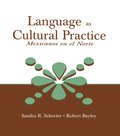- Table View
- List View
Language and Literature for the IB MYP 1
by Zara Kaiserimam Ana de CastroExam Board: IBLevel: MYPSubject: EnglishFirst Teaching: September 2016First Exam: June 2017Develop your skills to become an inquiring learner; ensure you navigate the MYP framework with confidence using a concept-driven and assessment-focused approach to Language and Literature presented in global contexts.- Develop conceptual understanding with key MYP concepts and related concepts at the heart of each chapter.- Learn by asking questions with a statement of inquiry in each chapter. - Prepare for every aspect of assessment using support and tasks designed by experienced educators.- Understand how to extend your learning through research projects and interdisciplinary opportunities.
Language and Literature for the IB MYP 2
by Zara KaiserimamA concept-driven and assessment-focused approach to Language and Literature teaching and learning.- Approaches each chapter with statements of inquiry framed by key and related concepts, set in a global context- Supports every aspect of assessment using tasks designed by an experienced MYP educator- Differentiates and extends learning with research projects and interdisciplinary opportunities- Applies global contexts in meaningful ways to offer an MYP Language and Literature programme with an internationally-minded perspective
Language and Literature for the IB MYP 2
by Zara KaiserimamA concept-driven and assessment-focused approach to Language and Literature teaching and learning.- Approaches each chapter with statements of inquiry framed by key and related concepts, set in a global context- Supports every aspect of assessment using tasks designed by an experienced MYP educator- Differentiates and extends learning with research projects and interdisciplinary opportunities- Applies global contexts in meaningful ways to offer an MYP Language and Literature programme with an internationally-minded perspective
Language and Literature for the IB MYP 3
by Gillian Ashworth Zara KaiserimamDevelop your skills to become an inquiring learner; ensure you navigate the MYP framework with confidence using a concept-driven and assessment-focused approach to Language and Literature presented in global contexts.- Develop conceptual understanding with key MYP concepts and related concepts at the heart of each chapter.- Learn by asking questions with a statement of inquiry in each chapter. - Prepare for every aspect of assessment using support and tasks designed by experienced educators.- Understand how to extend your learning through research projects and interdisciplinary opportunities.
Language and Literature for the IB MYP 3
by Zara Kaiserimam Gillian AshworthDevelop your skills to become an inquiring learner; ensure you navigate the MYP framework with confidence using a concept-driven and assessment-focused approach to Language and Literature presented in global contexts.- Develop conceptual understanding with key MYP concepts and related concepts at the heart of each chapter.- Learn by asking questions with a statement of inquiry in each chapter. - Prepare for every aspect of assessment using support and tasks designed by experienced educators.- Understand how to extend your learning through research projects and interdisciplinary opportunities.
Language and Literature for the IB MYP 4 & 5: By Concept (MYP By Concept)
by Gillian AshworthThe only series for MYP 4 and 5 developed in cooperation with the International Baccalaureate (IB)Develop your skills to become an inquiring learner; ensure you navigate the MYP framework with confidence using a concept-driven and assessment-focused approach to Language and Literature presented in global contexts.- Develop conceptual understanding with key MYP concepts and related concepts at the heart of each chapter.- Learn by asking questions with a statement of inquiry in each chapter. - Prepare for every aspect of assessment using support and tasks designed by experienced educators.- Understand how to extend your learning through research projects and interdisciplinary opportunities.This title is also available in two digital formats via Dynamic Learning. Find out more by clicking on the links at the top of the page.
Language and Literature for the IB MYP 4 & 5: By Concept (MYP By Concept)
by Gillian AshworthThe only series for MYP 4 and 5 developed in cooperation with the International Baccalaureate (IB)Develop your skills to become an inquiring learner; ensure you navigate the MYP framework with confidence using a concept-driven and assessment-focused approach to Language and Literature presented in global contexts.- Develop conceptual understanding with key MYP concepts and related concepts at the heart of each chapter.- Learn by asking questions with a statement of inquiry in each chapter. - Prepare for every aspect of assessment using support and tasks designed by experienced educators.- Understand how to extend your learning through research projects and interdisciplinary opportunities.
Language and Literature in a Glocal World
by Sandhya Rao MehtaThis collection of critical essays investigates the intersections of the global and local in literature and language. Exploring the connections that exist between global forms of knowledge and their local, regional applications, this volume explores multiple ways in which literature is influenced, and in turn, influences, movements and events across the world and how these are articulated in various genres of world literature, including the resultant challenges to translation. This book also explores the way in which languages, especially English, transform and continue to be reinvented in its use across the world. Using perspectives from sociolinguistics, discourse analysis and semiotics, this volume focuses on diasporic literature, travel literature, and literature in translation from different parts of the world to study the ways in which languages change and grow as they are sought to be ‘owned’ by the communities which use them in different contexts. Emphasizing on interdisciplinary studies and methodologies, this collection centralizes both research that theorizes the links between the local and the global and that which shows, through practical evidence, how the local and global interact in new and challenging ways.
Language and Media: A Resource Book for Students (Routledge English Language Introductions)
by Rodney H. Jones Sylvia Jaworska Erhan AslanRoutledge English Language Introductions cover core areas of language study and are one-stop resources for students. Assuming no prior knowledge, books in the series offer an accessible overview of the subject, with activities, study questions, sample analyses, commentaries, and key readings—all in the same volume. The innovative and flexible 'two-dimensional' structure is built around four sections—introduction, development, exploration, and extension— which offer self-contained stages for study. Each topic can also be read across these sections, enabling the reader to build gradually on the knowledge gained. This revised second edition of Language and Media: Provides an accessible introduction and comprehensive overview of the major approaches and methodological tools used in the study of language and media. Focuses on a broad range of media and media content from more traditional print and broadcast media formats to more recent digital media formats. Incorporates practical examples using real data, including newspaper articles, press releases, television shows, advertisements (print, broadcast, and digital), blogs, social media content, internet memes, culture jamming, and protest signs. Includes key readings from leading scholars in the field, such as Jan Blommaert, Sonia Livingstone, David Machin, Martin Montgomery, Ruth Page, Ron Scollon, and Theo van Leeuwen. Offers a wide range of activities, questions, and points for further discussion. The book emphasises the increasingly creative ways ordinary people are engaging in media production. It also addresses a number of urgent current concerns around media and media production/reception, including fake news, clickbait, virality, and surveillance. Written by three experienced teachers and authors, this accessible textbook is an essential resource for all students of English language and linguistics.
Language and Minority Rights: Ethnicity, Nationalism and the Politics of Language (Language In Social Life Ser.)
by Stephen MayThe second edition addresses new theoretical and empirical developments since its initial publication, including the burgeoning influence of globalization and the relentless rise of English as the current world language. May’s broad position, however, remains largely unchanged. He argues that the causes of many of the language-based conflicts in the world today still lie with the nation-state and its preoccupation with establishing a 'common' language and culture via mass education. The solution, he suggests, is to rethink nation-states in more culturally and linguistically plural ways while avoiding, at the same time, essentializing the language-identity link. This edition, like the first, adopts a wide interdisciplinary framework, drawing on sociolinguistics, applied linguistics, sociology, political theory, education and law. It also includes new discussions of cosmopolitanism, globalization, the role of English, and language and mobility, highlighting the ongoing difficulties faced by minority language speakers in the world today.
Language and Politics in the United States and Canada: Myths and Realities
by Thomas Ricento Barbara BurnabyThis volume critically analyzes and explains the goals, processes, and effects of language policies in the United States and Canada from historical and contemporary perspectives. The focus of this book is to explore parallel and divergent developments in language policy and language rights in the two countries, especially in the past four decades, as a basis for reflection on what can be learned from one country's experience by the other. Effects of language policies and practices on majority and minority individuals and groups are evaluated. Differences in national and regional language situations in the U.S. and Canada are traced to historical and sociological, demographic, and legal factors which have sometimes been inappropriately generalized or ignored by ideologues. The point is to show that certain general principles of economics and sociology apply to the situations in both countries, but that differing notions of sovereignty, state and nation, ethnicity, pluralism, and multiculturalism have shaped attitudes and policies in significant ways. Understanding the bases for these varying attitudes and policies provides a clearer understanding of the idiosyncratic as well as more universal factors that contribute to tensions between groups and to outcomes, many of which are unintended. The volume makes clear that language matters always involve issues of culture, economics, politics, individual and group identities, and local and national histories. The chapters provide detailed analyses on a wide range of issues at the national, state/provincial, and local levels in both countries. The chapter authors come from a variety of academic disciplines (education, geography, journalism, law, linguistics, political science, and sociology), and the findings, taken together, contribute to an evolving, interdisciplinary theory of language policy.
Language and Power in Post-Colonial Schooling: Ideologies in Practice (Language, Culture, and Teaching Series)
by Carolyn McKinneyCritiquing the positioning of children from non-dominant groups as linguistically deficient, this book aims to bridge the gap between theorizing of language in critical sociolinguistics and approaches to language in education. Carolyn McKinney uses the lens of linguistic ideologies—teachers’ and students’ beliefs about language—to shed light on the continuing problem of reproduction of linguistic inequality. Framed within global debates in sociolinguistics and applied linguistics, she examines the case of historically white schools in South Africa, a post-colonial context where political power has shifted but where the power of whiteness continues, to provide new insights into the complex relationships between language and power, and language and subjectivity. Implications for language curricula and policy in contexts of linguistic diversity are foregrounded. Providing an accessible overview of the scholarly literature on language ideologies and language as social practice and resource in multilingual contexts, Language and Power in Post-Colonial Schooling uses the conceptual tools it presents to analyze classroom interaction and ethnographic observations from the day-to-day life in case study schools and explores implications of both the research literature and the analyses of students’ and teachers’ discourses and practices for language in education policy and curriculum.
Language And Reading Disabilities
by Alan Kamhi Hugh CattsNow more than ever, increased attention has been given to students achieving adequate levels of reading proficiency. Maintaining its strong clinical and research basis, the third edition of Language and Reading Disabilities successfully keeps pace with the rapid changes in our knowledge about language and reading disabilities by providing readers with the most up-to-date advances in research and instruction in reading disabilities. This edition continues to cover a wide variety of theories by comparing and noting the similarities and differences between spoken and written language. This text is broad-based in its coverage of identification, assessment, and treatment of reading and writing disorders.
Language and Superdiversity: Recombining Spaces, Times And Language Practices (Encounters Ser. #7)
by Jan Blommaert Karel Arnaut Massimiliano Spotti Ben RamptonA first synthesis of work done in sociolinguistic superdiversity, this volume offers a substantial introduction to the field and the issues and state-of-the-art research papers organized around three themes: Sketching the paradigm, Sociolinguistic complexity, Policing complexity. The focus is to show how complexity rather than plurality can serve as a lens through which an equally vast range of topics, sites, and issues can be tied together. Superdiversity captures the acceleration and intensification of processes of social ‘mixing’ and ‘fragmentation’ since the early 1990s, as an outcome of two different but related processes: new post-Cold War migration flows, and the advent and spread of the Internet and mobile technologies. The confluence of these forces have created entirely new sociolinguistic environments, leading to research in the past decade that has brought a mixture of new empirical terrain–extreme diversity in language and literacy resources, complex repertoires and practices of participants in interaction–and conceptual challenges. Language and Superdiversity is a landmark volume bringing together the work of the scholars and researchers who spearhead the development of the sociolinguistics of superdiversity.
Language and Sustainable Development (Language Policy #32)
by Lisa J. McEntee-Atalianis Humphrey TonkinThis book addresses the importance of language in matters of sustainability and incorporating such concerns in implementing the UN’s Sustainable Development Goals (SDGs). Sustainable language policy must aim to include all groups, including language minorities and marginalized populations, such as refugees and aid recipients, in conditions that allow for their inclusion in making and implementing policy. The book brings together nine studies covering such topics as language and digital resources, sustainable and inclusive multilingual education, national language policy, and language in peacekeeping operations. A final chapter addresses the crucial intersection between sociolinguistics and economics, and the implications of this for development and the SDGs.
Language and the Curriculum: Practitioner Research in Planning Differentiation
by Carol Miller Deirdre MartinFirst Published in 1999. Routledge is an imprint of Taylor & Francis, an informa company.
Language and the Joint Creation of Knowledge: The selected works of Neil Mercer
by Neil MercerIn the World Library of Educationalists series, international experts themselves compile career-long collections of what they judge to be their finest pieces – extracts from books, key articles, salient research findings, major theoretical and practical contributions – so the world can read them in a single manageable volume. Readers will be able to follow the themes and strands and see how their work contributes to the development of the field. Language and the Joint Creation of Knowledge draws on the most prominent writing of Neil Mercer, covering his ground-breaking and critically acclaimed work on the role of talk in education, and on the relationship between spoken language and cognition. The text explores key themes, relating theoretical ideas to research evidence and to practical educational situations that improve children’s lives. Offering students and researchers a clear, accessible and up-to-date account of a sociocultural perspective on the relationship between spoken language and cognition, it explains one of the key themes in Neil Mercer’s work – that humans have uniquely evolved the capacity to think together, or ‘interthink’. Offering a crucial insight into the work of Neil Mercer, this selection showcases why his approach has become the dominant paradigm in educational research, and why it is increasingly influential in the psychology of teaching and learning. This unique collection of published articles and chapters, which represent the key themes and range of his research over the last 40 years, will be of interest to all followers of his work and any reader interested in the role of language in education.
Language Around the World: Ways we Communicate our Thoughts and Feelings
by Gill BudgellDiscover fascinating facts about communication in all its forms, from around the world and over timeEngaging factual writing introduces young readers to the most interesting aspects of languages, how they evolve and change over time. Humans&’ use of language is one of our distinguishing features. Language allows us to communicate what we think, what we want, what we feel, and what we have learned. Some 100,000 years ago, humans began speaking. Since then, we have developed nearly 7000 languages. Languages are living things; they evolve and change over time. They even travel! People carry their language with them and spread it. Large language families even have their own family trees, such as Spanish, French, English. Different languages can be mixed and combined to create new languages with similar words, pronunciation, and grammar rules. Languages can even become extinct if they are not shared and learned by each new generation. Spoken languages are not the only way we communicate. Sign language, Morse code, semaphore, smoke signals, computer codes - humans have invented numerous ways of communicating. Sharing feelings, thoughts, and ideas through the power of language is an essential part of being human.
Language Arts: Integrating Skills for Classroom Teaching
by Mildred R. DonoghueProvides a clear and succinct introduction to teaching the language arts to elementary studentsKey FeaturesFocuses on integrating the six language arts—reading, writing, listening, speaking, viewing, and visually representing—with other subject areasProvides guidance on differentiating instruction to bring out the best in the rapidly growing number of students with special needs and English language learners in the regular classroomIncludes a detailed lesson plan in each chapter along with instructional activities and techniques to integrate the language arts across all the subjects in the elementary curriculumAccompanied by High-Quality Ancillaries!Student Resource CD: Bundled with the book, this CD includes video clips and discussion questions that correlate with important chapter concepts.This interactive study site provides practice tests, flashcards, chapter summaries, links to NCTE/IRA and state-specific Language Arts standards, and much more.Instructor Resources on CD: Available by contacting SAGE Customer Care at 1-800-818-SAGE (7243), this CD for instructors offers resources such as lecture outlines, PowerPoint slides, a test bank, and sample syllabi for semester and quarter courses.Intended AudienceThis book is intended for undergraduate and graduate courses in elementary language arts methods, which teaches pre-service teachers and licensure/certification candidates specifically how to teach their students the basics of the six language arts – reading, writing, listening, speaking, viewing, and visually representing.
Language Arts: Patterns Of Practice
by Gail TompkinsThe best selling language arts text in the market, Language Arts: Patterns of Practice continues to ground language arts instruction in the contemporary classroom. Its strengthened focus on the needs of English learners, as well as its new coverage of Common Core Standards for English Language Arts and its integrated treatment of technology as a teaching tool combine to make this new edition an invaluable tool for pre-service and elementary language arts teachers.
Language Arts: Patterns of Practice,8th Edition
by Gail E. TompkinsThe best selling language arts text in the market, Language Arts: Patterns of Practice continues to ground language arts instruction in the contemporary classroom. Its strengthened focus on the needs of English learners, as well as its new coverage of Common Core Standards for English Language Arts and its integrated treatment of technology as a teaching tool combine to make this new edition an invaluable tool for pre-service and elementary language arts teachers.
Language Arts in Action: Engaging Secondary Students with Journalistic Strategies
by Ed Madison Melissa Wantz Rachel GuldinBuild communication skills that can last a lifetime. To adolescents enthralled by the instant gratification of social media, the pace of classroom routines can seem glacial. How can educators engage today’s “swipe-happy” students and prepare them to thrive in a world where disinformation is as easy to absorb as information? Language Arts in Action is a thoughtful guide for middle and high school educators wanting to reengage their classes with more active, student-centered instruction. Here, teachers will find tools rooted in journalistic learning: a model that uses project-based storytelling to develop critical communication skills. By allowing young people to research, write, and publish articles aligned with their interests, educators can transform language arts, especially for students who feel their experiences and concerns are missing from traditional instruction.
Language as a Local Practice
by Alastair PennycookLanguage as a Local Practice addresses the questions of language, locality and practice as a way of moving forward in our understanding of how language operates as an integrated social and spatial activity. By taking each of these three elements – language, locality and practice – and exploring how they relate to each other, Language as a Local Practice opens up new ways of thinking about language. It questions assumptions about languages as systems or as countable entities, and suggests instead that language emerges from the activities it performs. To look at language as a practice is to view language as an activity rather than a structure, as something we do rather than a system we draw on, as a material part of social and cultural life rather than an abstract entity. Language as a Local Practice draws on a variety of contexts of language use, from bank machines to postcards, Indian newspaper articles to fish-naming in the Philippines, urban graffiti to mission statements, suggesting that rather than thinking in terms of language use in context, we need to consider how language, space and place are related, how language creates the contexts where it is used, how languages are the products of socially located activities and how they are part of the action. Language as a Local Practice will be of interest to students on advanced undergraduate and post graduate courses in Applied Linguistics, Language Education, TESOL, Literacy and Cultural Studies.
Language as Cultural Practice: Mexicanos en el Norte
by Sandra R. Schecter Robert J. BayleyLanguage as Cultural Practice: Mexicanos en el Norte offers a vivid ethnographic account of language socialization practices within Mexican-background families residing in California and Texas. This account illustrates a variety of cases where language is used by speakers to choose between alternative self-definitions and where language interacts differentially with other defining categories, such as ethnicity, gender, and class. It shows that language socialization--instantiated in language choices and patterns of use in sociocultural and sociohistorical contexts characterized by ambiguity and flux--is both a dynamic and a fluid process. The study emphasizes the links between familial patterns of language use and language socialization practices on the one hand, and children's development of bilingual and biliterate identities on the other. Using a framework emerging from their selection of two geographically distinct localities with differing demographic features, Schecter and Bayley compare patterns of meaning suggested by the use of Spanish and English in speech and literacy activities, as well as by the symbolic importance ascribed by families and societal institutions (such as schools) to the maintenance and use of the two languages. Language as Cultural Practice: *provides a detailed account of the diversity of language practices and patterns of use in language minority homes; *offers educators detailed information on the language ecology of Latino homes in two geographically diverse communities--San Antonio, Texas, and the San Francisco Bay Area, California; *shows the diversity within Mexican-American communities in the United States--families profiled range from rural families in south Texas to upper middle class professional families in northern California; *provides data to correct the prevalent misconception that maintenance of Spanish interferes with the acquisition of English; and *contributes to the study of language socialization by showing that the process extends throughout the lifetime and that it is an interactive rather than a one-way process. This book will particularly interest researchers and professionals in linguistics, anthropology, applied linguistics, and education, and will be useful as a text in graduate courses in these areas that address language socialization and learning.
Language Assessment: Principles And Classroom Practices
by H. BrownLanguage Assessment: Principles and Classroom Practices is designed to offer a comprehensive survey of essential principles and tools for second language assessment. Its first and second editions have been successfully used in teacher-training courses, teacher certification curricula, and TESOL master of arts programs. As the third in a trilogy of teacher education textbooks, it is designed to follow H. Douglas Brown's other two books, Principles of Language Learning and Teaching (sixth edition, Pearson Education, 2014) and Teaching by Principles(fourth edition, Pearson Education, 2015). References to those two books are made throughout the current book. <P><P> Language Assessment features uncomplicated prose and a systematic, spiraling organization. Concepts are introduced with practical examples, understandable explanations, and succinct references to supportive research. The research literature on language assessment can be quite complex and assume that readers have technical knowledge and experience in testing. By the end of Language Assessment, however, readers will have gained access to this not-so-frightening field. They will have a working knowledge of a number of useful, fundamental principles of assessment and will have applied those principles to practical classroom contexts. They will also have acquired a storehouse of useful tools for evaluating and designing practical, effective assessment techniques for their classrooms.
